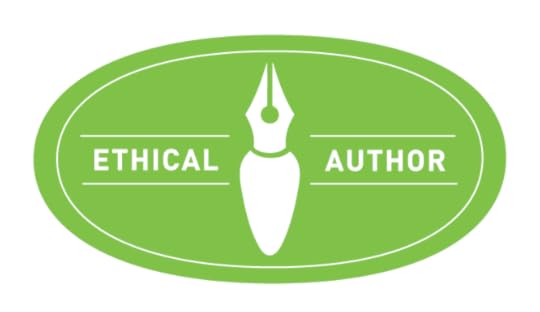Massimo Marino's Blog: The Ramblings and the Rumblings, page 14
December 21, 2014
The Last Colony – John Scalzi
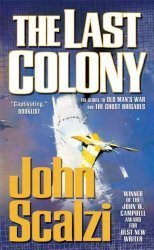
 Could John Perry, be satisfied with the peaceful life as the Ombudsman of a peaceful colony, after spending the previous years of his life in constant danger, as a soldier of the Colonial Defense Forces?
Could John Perry, be satisfied with the peaceful life as the Ombudsman of a peaceful colony, after spending the previous years of his life in constant danger, as a soldier of the Colonial Defense Forces?
And what about his wife, Jane Sagan, who—in a sense—was born in that life full of danger?
The Colonial Union ask them to embark on a new adventure. The list of candidates was not very long, and the two of them were not right at the top, but they were candidates nonetheless, and they had the right spirit and attitudes.
The mission? Supervise the start of a new colonization with elements taken from different colonies, the top ten even. An experiment never attempted before. A challenge.
But of course things are not as they seem, and many dangers come from any source, even the most unexpected.
John Scalzi returns to his fictional universe of the Old Man’s War, soon to be made on TV, apparently.
John Scalzi presents the ordinary world of John, made of small disputes, placid pace of life, and brings us seamlessly into an adventure, a series of twists and inventions that greet you almost at every turn of the page.
It’s difficult to get into the detail of the story without giving too much away, and there are so many narrative twists. When we think we have it all figured out, that you understand what the rip-off is, when we begin to despair for the fate of John and Jane and the adopted daughter Zoe, Scalzi pulls off the right trick, a trick that solves the situation and continues the story, answers the questions, but also poses new ones.
Actually, not really tricks á la Deus Ex Machina, of course, but interlocking logic, surprisingly simple in hindsight.
Continuing to exploit stylistic elements from various genres, Scalzi begins with almost comedy tones, then draws the handful of western epic, stirring well with all the intrigues of political and legal thrillers, and adds in the background some military science fiction.
In fact, if the SF military relationships between the characters are essentially related to the various ranks and having to accept and respect orders according to a hierarchy, this time John (the character, not the author) has to earn respect on the basis of his actions, his decisions pulled out in a short time and in extreme situations.
The novel is—once again—narrated in the first person, from the point of view of the old man, John, but Scalzi manages to detach from the limitations of the 1st POV with narrative skills in a few moments when the protagonist reconstructs what happens around him. The result is of a greater understanding than what you would normally achieve in a novel written with the narrow point of view of the protagonist.
In conclusion, The Last Colony (Old Man’s War) is read with pleasure. A good science fiction entertainment, regardless of gender. It is true that it stirs many already-seen situations, many ideas seen since ever in the history of science fiction, but as always, how they are presented makes a difference. And in this case the mixture seems to work.
is read with pleasure. A good science fiction entertainment, regardless of gender. It is true that it stirs many already-seen situations, many ideas seen since ever in the history of science fiction, but as always, how they are presented makes a difference. And in this case the mixture seems to work.
The post The Last Colony – John Scalzi appeared first on § Author Massimo Marino.
December 18, 2014
The Science of Interstellar
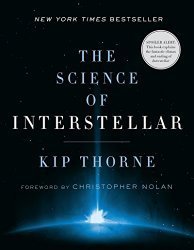
 Interstellar is causing rivers of electronic ink flow in turmoil. It is not a common thing to see a science fiction film received with so much controversy. The public seems to be divided into two camps: those who judge the film by Christopher Nolan a masterpiece, and those who destroy it mercilessly. Among the latter, many attack the film right on that aspect that should be the movie’s strongest point: its scientific plausibility.
Interstellar is causing rivers of electronic ink flow in turmoil. It is not a common thing to see a science fiction film received with so much controversy. The public seems to be divided into two camps: those who judge the film by Christopher Nolan a masterpiece, and those who destroy it mercilessly. Among the latter, many attack the film right on that aspect that should be the movie’s strongest point: its scientific plausibility.
Just for the latter, a very interesting take is from the book—released to coincide with the film—The Science of Interstellar, signed by that Kip Thorne scientist who is also the scientific advisor for the script, and one of the leading experts in blacks holes, curved space, quantum effects on gravity and time.
The book, in English, aims at readers with an average science education. Kip Thorne is the Feynman Professor of Theoretical Physics Emeritus at Caltech, USA.
How well did the Interstellar?
In the introduction, Thorne tells how the project of Interstellar was born. In a phase of his life, Thorne was single and trying to raise a child alone — in Interstellar, the father-daughter relationship is central — and came to know that Carl Sagan, with whom Thorne was in close friendship, had organized an appointment with Lynda Obst, a former journalist who was trying to break into the world of movies as a producer. The two had a brief romantic relationship, but even if in the end it did not work they remained good friends.
Years later, in 2005, Obst, who had produced Contact, the film based on the novel by Sagan, proposed to Thorne to work on a script on a similar subject. Thorne became interested in the idea, and in the next four months he knocked off what would have been the subject of Interstellar, with inside all the topics that interested Thorne: blacks holes, wormholes, gravitational waves.
Obst was pretty good at her job, and was able to engage a big-time screenwriter, Jonathan Nolan, and Steven Spielberg as director. But the project with Spielberg was wrecked, and for a couple of years it seemed that everything would end and lost to oblivion. Then Obst succeeded in involving Christopher Nolan, and Interstellar, the project, received a fresh, new start.
Scientific Consultant
The script was re-written by Jonathan Nolan this time together with Christopher, and with the advices from Thorne. The thing, says Thorne, worked like this: Nolan said Thorne what had to happen in the film, and Thorne had to find the scientific justification.
In the book, Thorne explains how they dealt with various aspects of scientific history. For example, as regards to the first part, for the blight that is destroying all plants on Earth, Thorne invited to dinner the elite of his university’s biology and medicine, and, sitting around the table, began to make assumptions in order to give a scientific explanation the type of disease that was described in the script. After discarding many assumptions, the conclusion reached by the group was that yes, it was possible — although not very likely — that a certain type of organism would evolve to become able to attack the chloroplasts and then kill plants and decrease the percentage of oxygen in ‘atmosphere. The implausibility, however, is that the effect could be as rapid spreading as the one described in the film, unless one hypothesizes, for example, that the amount of plants on the bottom of the oceans is much higher than what is estimated today together with their contribution to the atmosphere.
Others, like Phil Plait, criticized the fact that the planet Miller was so close to the black hole to be subject to such a strong time contraction (every hour on the planet was equivalent to seven years for the ship in orbit) and, yet, without being destroyed by tidal forces of the black hole.
The idea, though, was not Thorne’s, who reveals that Chris Nolan has basically imposed how things were, then asked him to find a scientific explanation. Thorne found it then by assuming that the black hole had a huge mass (similar to blacks holes at the center of galaxies) and rotated very fast. The same Plait later admitted that he had considered the rotation, and that he was wrong in formulating its critics. Things remains that different mathematical models can give different answers to the same questions.
Things Unscientific
Not all things went as Thorne wanted. The biggest regret of the scientist was the elimination in the plot of gravitational waves, a theme he was very keen to explore in the movie (being a subject that has long occupied in his career). But it became too complex and the story would not hold well together.
In other cases his advice has not been used for artistic reasons. Thorne is very proud of the representation of the black hole, visible in its glorious, real appearance for the first time in the rendered images of Interstellar. The computer provided the answer through complex calculations based on studies from Thorne. Conversely, the calculations performed by Thorne to see the shift in the wormhole were discarded because the effect would be too similar to things already seen in other science fiction films (imagine the effect warp of Star Wars or Star Trek); Nolan then decided to use something completely different.
Is There a Way to Travel Between Stars?
In a very interesting chapter, Thorne also addresses the theme of travel in the interstellar space. As we know, the nearest stars are a few light years away, and to reach them with today’s engines would require thousands of years. Thorne analyzes five or six kind of propulsion that would allow a ship to travel at speeds reasonably close to the speed of light; interesting hypothesis, but all, concludes Thorne rather improbable and still quite beyond our current capabilities.
The only possibility is therefore the wormhole. But wormholes may exist?
The idea of wormholes dates back to 1916, and was theorized by the Viennese physicist Ludwig Flamm. Later, the topic was studied by Einstein himself with Nathan Rosen, and the two gave the name to that effect that is known as the “Einstein-Rosen bridge,” while the term ‘wormhole’ was coined by another great astrophysicist, John Wheeler.
The concept works like this: a caterpillar who wants to move from side to side of the apple has two roads; circumnavigate the apple, or dig a tunnel and go through it. Essentially two-dimensional universe is coming out of the surface of the apple to get into a different dimension that “cut” through the space between two points of the universe-apple.
Thorne explains how a natural wormhole is completely unstable and would have no more than a few seconds before it evaporates. However, by including in the wormhole exotic matter, you can lock the wormhole, expand it, and make it stable. In essence, says Thorne, wormholes are possible, but only artificial ones. This allowed Thorne to win a bet with Steven Hawking, who argued the impossibility of a stable wormhole. Hawking agreed to pay the bet, but argued on the regularity of the solution, because the artificial wormhole should not have been foreseen as part of the bet.
Thorne, of course, knows his subject, and we must recognize that he’s also very good at exposing, captivating the reader, and entertain him with a hint of irony.
Massimo Marino is a scientist envisioning science fiction. He spent years at CERN and The Lawrence Berkeley Lab followed by lead positions with Apple, Inc. and the World Economic Forum. He is also co-founder of “Squares on Blue”, a Big Data Analytics service company.
Massimo currently lives in France and crosses the border with Switzerland multiple times daily, although he is no smuggler.
As a scientist writing science fiction, he went from smashing particles at accelerators at SLAC and CERN to smashing words on a computer screen.
He’s the author of multi-awarded Daimones Trilogy.
His novels have received the Seal of Excellency from both AwesomeIndies.net and IndiePENdents.org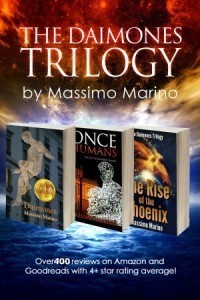
• 2012 PRG Reviewer’s Choice Award Winner in Science Fiction
• 2013 Hall of Fame – Best in Science Fiction, Quality Reads UK Book Club
• 2013 PRG Reviewer’s Choice Award Winner in Science Fiction Series
• 2014 Finalist – Science Fiction – Indie Excellence Awards L.A.
• 2014 Award Winner – Science Fiction Honorable Mention – Readers’ Favorite Annual Awards
His novels are available from Amazon, Barnes & Noble (Nook), iTunes Apple Store, and many other retailers around the world.
Join his mailing list for new releases, or follow him on Facebook, Google+, and Twitter.
The post The Science of Interstellar appeared first on § Author Massimo Marino.
December 16, 2014
Alchemist of Words
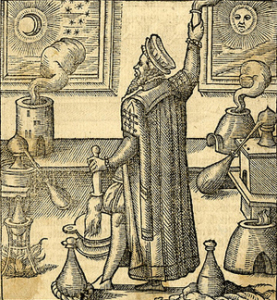 How many of you have confessed to a stranger that you are a writer only to be told that they too are planning to take a month off to write a book? Yet, can any of us imagine saying to a brain surgeon that we’d take a month off to learn to operate on the brain? (One writer friend claims to have said exactly that to a doctor after the doctor said he was going to write a book during a two-week holiday.)
How many of you have confessed to a stranger that you are a writer only to be told that they too are planning to take a month off to write a book? Yet, can any of us imagine saying to a brain surgeon that we’d take a month off to learn to operate on the brain? (One writer friend claims to have said exactly that to a doctor after the doctor said he was going to write a book during a two-week holiday.)
Those who don’t write often think writing is easy, something to be whipped out on whim. You put words on paper in a recognizable format making sentences with a subject, verb, a direct object, maybe a preposition here or there. Add a period, a question mark or more rarely an exclamation point. Then after the first sentence, there’s another and another, until you have a paragraph, a page, a story, a novel. It’s simple, it’s magic, right?
Good writing does not appear like magic. It takes work, discipline, commitment. As writers we are like those alchemist using all known elements and try them in different compounds, with the hope to turn lead into gold.
It is not any noun or verb committed to paper that turns our work from a jingle into an opera, it is which noun and which verb is the best. It is building a sentence, a paragraph, a story, a novel as deliberately as carpenters construct a house.
Words aren’t just squiggly lines on paper. They have power to those that can decipher them. Words carry weight, give color, make music. Words can say things that aren’t there, reveal secrets, tell truths or lie.
We, as writers, choose which words to give the power to conjure our thoughts and visions. Sometimes they flow out of fingertips faster than we can type. Other times they stay locked in boxes as we search frantically for the key. One writer I know, when she can’t find the right word puts in a wrong one and marks it with color. She confessed that she will get up in the middle of the night if she wakes knowing the word that escaped her earlier to fire up the computer and scroll down until she finds the color and substitutes the better word. She says she needs to commit to a word. To know that it is that word and no other, that anything other than the final word she has chosen will weaken her story.
Writers go over each sentence to decide whether to change a word here or there, rearrange the order, take out or add a detail.
When we start as writers we are often happy just to get the words on paper. As we learn our craft, we then begin to control our finished projects by realising that we can do without that adjective, we are better to show that action rather than tell about it, we, at times, can say more by not saying it at all, and hide things for the readers to discover themselves. At this point, our writing although perhaps still inspired, becomes polished AND inspired. We become more confident that we have truly nailed that phrase rather than doubt our ability. We also develop an instinct of when, where and how our writing can be better.
Writing calls for deliberate and constant decisions not just on what our characters do, say, look like, and feel, but the language we use to describe all this. If a journey starts with a single step, a story starts with a word.
Is the color to describe the flower lilac, mauve, lavender, purple? Does the child run, lope, gallop, stumble across the yard? Is anger shown by throwing a vase or dropping it on purpose? Are her eyes guarded, open, laughing, tear-filled? Does he stare, gaze, or glare? Whenever we choose one over another we are creating a different formula, a different alchemy, and sometimes a common metal starts to glitter.
Then, when we have the right words in the right sequences, we further commit ourselves to stacking them together in a way that pulls our readers along with us.
For example think of the following four sentences:
· She was sitting on a chair.
· She sat on the chair.
· She sat on her chair.
· She was rooted to her chair.
The last sentence gives a much stronger image to the reader than the rather mundane first one. Yet, there may be a time when we want the mundane. The difference is when we consciously select the right words to create the right tone. That is when we sculpt with words, we become wordsmiths, and word alchemists.
I take pride to tell people I am a writer of three books now, and writing a fourth, but now I’m seriously thinking when someone asks me what I do, I will say “I’m a word alchemist.”
Massimo Marino is a scientist envisioning science fiction. He spent years at CERN and The Lawrence Berkeley Lab followed by lead positions with Apple, Inc. and the World Economic Forum. He is also co-founder of “Squares on Blue”, a Big Data Analytics service company.
Massimo currently lives in France and crosses the border with Switzerland multiple times daily, although he is no smuggler.
As a scientist writing science fiction, he went from smashing particles at accelerators at SLAC and CERN to smashing words on a computer screen.
He’s the author of multi-awarded Daimones Trilogy.
His novels have received the Seal of Excellency from both AwesomeIndies.net and IndiePENdents.org
• 2012 PRG Reviewer’s Choice Award Winner in Science Fiction
• 2013 Hall of Fame – Best in Science Fiction, Quality Reads UK Book Club
• 2013 PRG Reviewer’s Choice Award Winner in Science Fiction Series
• 2014 Finalist – Science Fiction – Indie Excellence Awards L.A.
• 2014 Award Winner – Science Fiction Honorable Mention – Readers’ Favorite Annual Awards
His novels are available from Amazon, Barnes & Noble (Nook), iTunes Apple Store, and many other retailers around the world.
Join his mailing list for new releases, or follow him on Facebook, Google+, and Twitter.
The post Alchemist of Words appeared first on § Author Massimo Marino.
December 8, 2014
Italo Calvino’s Keys to Great Writing
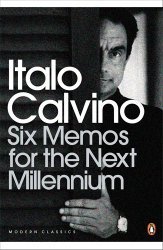
 Calvino shared in Bukowski’s assertion that writing should come “unmasked out of your heart and your mind and your mouth and your guts.” About himself, Calvino said “I’m a regular guy, I like well-defined outlines, I’m old-fashioned, bourgeois. My stories are full of facts, they have a beginning and an end. For that reason they will never be able to find success with the critics, nor occupy a place in contemporary literature.” He became one of the most revered authors in Italy and in the world.
Calvino shared in Bukowski’s assertion that writing should come “unmasked out of your heart and your mind and your mouth and your guts.” About himself, Calvino said “I’m a regular guy, I like well-defined outlines, I’m old-fashioned, bourgeois. My stories are full of facts, they have a beginning and an end. For that reason they will never be able to find success with the critics, nor occupy a place in contemporary literature.” He became one of the most revered authors in Italy and in the world.
In 1985, Calvino was offered the term of the prestigious Charles Eliot Norton Professorship of Poetry — Harvard’s annual lectureship. He rushed to put on paper the six lessons that he intended to deliver at Harvard but he died before completing the task and never lectured at Harvard.
The lectures have been published as the Six Memos for the Next Millennium and what follows here are some of those pearls in writing and publishing.
and what follows here are some of those pearls in writing and publishing.
The moment an object appears in a narrative, it is charged with a special force and becomes like the pole of a magnetic field, a knot in the network of invisible relationships. The symbolism of an object may be more or less explicit, but it is always there. We might even say that in a narrative any object is always magic.
To me this is a hint that in fiction everything has to have a role in the plot. All details, objects, situations, words, are there because of the necessity of their presence. Chekov is known to have said “If in the first act you have hung a pistol on the wall, then in the following one it should be fired. Otherwise don’t put it there.” Calvino stresses the importance of this concept:
Everything mentioned has a necessary function in the plot. The very first characteristic of a folktale is economy of expression. The most outlandish adventures are recounted with an eye fixed on the bare essentials. There is always a battle against time, against the obstacles that prevent or delay the fulfillment of a desire or the repossession of something cherished but lost. Or time can stop altogether, as in the castle of Sleeping Beauty.
Narrative is rhythm, pace, and the flow of words modifies the perception of time in narration. Calvino says:
Narrative time can also be delaying, cyclic, or motionless. In any case, a story is an operation carried out on the length of time involved, an enchantment that acts on the passing of time, either contracting or dilating it.
This is a passage that resonates with me because of my Sicilian origins:
Sicilian storytellers use the formula “lu cuntu nun metti tempu” (time takes no time in a story)… It leaves out unnecessary details but stresses repetition: for example, when the tale consists of a series of the same obstacles to be overcome by different people. A child’s pleasure in listening to stories lies partly in waiting for things he expects to be repeated: situations, phrases, formulas. Just as in poems and songs the rhymes help to create the rhythm, so in prose narrative there are events that rhyme.
Remark how “lu cuntu”—the story—”leaves out unnecessary details but stresses repetition”. It is here where we deal—in fact—with themes and memes in our narration. Those elements that constitute the glue within the story, the links in the chain of events that reinforce the message, explicit or implicit, that the symbols represent in a narration. I like the idea of ‘events that rhyme,’ that turn a story into a song.
Calvino tells us about successful writing, and what distinguishes the casual writing from narrative. In his words, I senses the mantra of “cull all unnecessary words.”
… success consists in felicity of verbal expression, which every so often may result from a quick flash of inspiration but as a rule involves a patient search for the mot juste, for the sentence in which every word is unalterable, the most effective marriage of sounds and concepts. I am convinced that writing prose should not be any different from writing poetry. In both cases it is a question of looking for the unique expression, one that is concise, concentrated, and memorable.
and to achieve that, the writer needs to use the scalpel and remove all that’s fat, redundant, unnecessary.
Certainly literature would never have existed if some human beings had not been strongly inclined to introversion, discontented with the world as it is, inclined to forget themselves for hours and days on end and to fix their gaze on the immobility of silent words.
The post Italo Calvino’s Keys to Great Writing appeared first on § Author Massimo Marino.
A Spellbinding Thriller – Shatter Point
Pick up a copy of this spellbinding thriller.
You can also enter the giveaway at the end of this post with no more than a click of the mouse for a chance to win a $75 Amazon or B&N gift card! Extra entry points will be available for anyone who posts a verified review before 1/23/2015!
“A thriller that grabs readers and doesn’t let go, skillfully twisting, turning, and manipulating its plot for maximum impact.” – Donovan, eBook Reviewer, Midwest Book Review
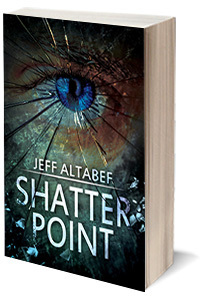 Evolved Publishing presents a gripping glimpse of the near future, in which a twisted serial killer finds power in a corrupt political culture.
Evolved Publishing presents a gripping glimpse of the near future, in which a twisted serial killer finds power in a corrupt political culture.
When her 19-year-old son Jack miraculously recovers from a serious head trauma, Maggie is sure her luck has changed. But when she’s abducted by a shadow from her past – a phantom with dangerous sapphire eyes – it’s up to Jack and his younger brother Tom to unravel the mystery and save their mom from a deadly psychological battle.
The brothers seek help from their colorful great aunt, who exposes them to a world of nefarious family secrets, explosive government conspiracies, and a series of horrific murders. Together they must navigate a dark underworld full of political subterfuge and class warfare.
Yet as they search for their mother, Jack changes—raked by skull splitting headaches and weird visions. How exactly did he recover from his coma, and how does this tie into the psychopath who’s abducted their mother?
Will Jack and Tom save Maggie before her abductor reaches his shatter point? Does Jack have enough time left?
~~~~~
“Shatter Point is an exciting novel of suspense, action, drama and even a little bit of horror…. It’s definitely one of the best novels out there right now.” – Next Page Reviews
“When I reached the last 100 pages no one was going to be able to stop me reading until I knew the ending!” – Olivia’s Catastrophe
~~~~~
The post A Spellbinding Thriller – Shatter Point appeared first on § Author Massimo Marino.
November 24, 2014
Ethical Author
ETHICAL AUTHOR CODE
I’m an Ethical Author
A couple of weeks ago the Alliance of Independent Authors announced the establishment of an Ethical Author Code in response to a general concern about the behaviour of some authors, both self-published and traditionally published. Like the vast majority of authors I know, I already follow the principles behind this code but I believe there is a real value in stating this more explicitly.
I would encourage any of my author friends to also publicly commit to this code. It doesn’t cost you anything, you aren’t signing up to an organisation, it is just a public declaration to behave responsibly and ethically in all aspects of your writing career.
To find out more, please either click on the image above.
Guiding principle
Putting the reader first
When I market my books, I put my readers first. This means that I don’t engage in any practices that have the effect of misleading the readers/buyers of my books. I behave professionally online and offline when it comes to the following practices in my writing life:
Courtesy
I behave with courtesy and respect toward readers, other authors, reviewers and industry professionals such as agents and publishers. If I find myself in disagreement, I focus on issues rather than airing grievances or complaints in the press or online, or engaging in personal attacks of any kind.
Aliases
I do not hide behind an alias to boost my own sales or damage the sales or reputation of another person. If I adopt a pen name for legitimate reasons, I use it consistently and carefully.
Reviewing and Rating books
I do not review or rate my own or another author’s books in any way that misleads or deceives the reader. I am transparent about my relationships with other authors when reviewing their books.
I am transparent about any reciprocal reviewing arrangements, and avoid any practices that result in the reader being deceived.
Reacting to reviews
I do not react to any book review by harassing the reviewer, getting a third party to harass the reviewer, or making any form of intrusive contact with the reviewer. If I’ve been the subject of a personal attack in a review, I respond in a way that is consistent with professional behaviour.
Book Promotions
I do not promote my books by making false statements about, for example, their position on bestseller lists, or consent to anyone else promoting them for me in a misleading manner.
Plagiarism
I know that plagiarism is a serious matter, and I don’t intentionally try to pass off another writer’s words as my own.
Financial ethics
In my business dealings as an author, I make every effort to be accurate and prompt with payments and financial calculations. If I make a financial error, I remedy it as soon as it’s brought to my notice.
Responsibility
I take responsibility for how my books are sold and marketed. If I realise anyone is acting against the spirit or letter of this Code on my behalf, I will refer them to this Code and ask them to modify their behaviour.
The post Ethical Author appeared first on § Author Massimo Marino.
November 13, 2014
Dealing with Grief
 Witnessing real grief is easy. Turn on the news. An Iraqi father holds his dead daughter, a Palestinian woman looks numb as she sits on the rubbles of her house and tells of the hacking of her family and how she is the only survivor. Anyone who has seen FAHRENHEIT 9/11 by Michael Moore remembers the mother of a dead soldier who goes to Washington, DC. A woman attacks her verbally. Then the mother walks toward the White House. Suddenly she bends over in a pain that permeates from the screen into every cell of the watcher.
Witnessing real grief is easy. Turn on the news. An Iraqi father holds his dead daughter, a Palestinian woman looks numb as she sits on the rubbles of her house and tells of the hacking of her family and how she is the only survivor. Anyone who has seen FAHRENHEIT 9/11 by Michael Moore remembers the mother of a dead soldier who goes to Washington, DC. A woman attacks her verbally. Then the mother walks toward the White House. Suddenly she bends over in a pain that permeates from the screen into every cell of the watcher.
An example of shown grief can be found in BROADBACK MOUNTAIN. The lover holds a shirt against his body and we know it contains a memory, and we know he regrets not having the courage to go with his lover. The mother, devastated by her own grief, lets him take the clothing away without ever admitting she knows the true relationship between her son and the guest. The pain is there, but it is never spoken. The actions say more than any dialogue.
“One of the most important accomplishments of fiction is to connect readers with characters,” says John Thornton Williams. “Revealing the interiority of a character in a way that feels natural, yet resonates powerfully within a reader is one of the most difficult tasks of the fiction writer.” Williams continues to say that “There are occasions in fiction where it’s appropriate for a narrator to say, “So-and-so felt sad/happy/anxious.” But rarely are such basic expositions enough… [...] a lengthy expository digression into the psyche of a character, perhaps accompanied by physical cues, i.e., So-and-so felt more upset than he’d felt in his entire life, so upset he thought he might die, his stomach was in a knot, his throat was on fire… generally proves detrimental.”
This pain is what a writer needs to capture, not just for the three-minute newscast but what happens the next day, week, month, however long the character stays with the story. The reader needs to know how the loss is internalized into the character.
This is where showing versus telling comes into play. Writing about grief is one of the hardest things to do because it is so easy to slip into sentimentality and that dilutes the pain.
Details show grief. They show how the character is changed by the tragedy, whatever that might be. Is there rage, a shutdown of emotion, fear, denial or acceptance – all the normal stages according to the work of Elisabeth Kubler-Ross? The recognized stages when dealing with make fertile ground for a writer.
Beware, though, we don’t want to tritely run our character through the stages showing a situation for each stage. Having different characters caught in different stages can set up conflict that adds to the drama of your work. A sister who refused to think about her dead brother, a mother who accepts his death because it released him from the pain of AIDS, his father’s anger that his son was gay can all illustrate grief over the same death.
“A third option,” says Williams, “—what I’ll call indirection of image—is often a more successful approach, at least in crisis moments in a story, places where emotions are most charged and complex. By indirection of image, I mean an instance where a writer takes into consideration how a certain character would experience a particular setting or image based on his/her emotional state. Something as simple as a car parked on the street surely looks different to a lottery winner than to someone who just got evicted. In other words, indirection of image is a way to take abstract emotions and project them onto something concrete.”
Recovery from grief is not a timed event. A woman that twenty years later is still massaging everything her ex-husband said and did when he walked out is frozen in her grief but is in a different situation from a woman who comes across photos from her first marriage that triggers the rage she felt when her husband left her despite having a happy life since then. The way the grief is handled by each tells more about the character than if you said one was depressive and the other optimistic or whatever seemed appropriate.
SAMPLES
• The protagonist Worrel takes his lover, Angie, who is sick with terminal cancer, to the hospital. Angie is married. Needless to say, the emotions at play here are vast and complicated.
Sitting in a hospital’s waiting room, Worrel comes to view a copy of Newsweek magazine—something that at first glance (or first draft) might seem insignificant to the story: “…The sheer amount of work that had gone into producing the magazine he held in his hands made him tired. Lumberjacks had felled trees that had been shredded and pulped to make paper. Ink had to come from somewhere. Other folks ran presses, stacked the glossy magazine, delivered them; the US Mail shuttled them across the country… . The magazine grew inordinately heavy, all these labors had freighted it with excess weight. He could hardly hold it.” – William Gay “My hand is just fine where it is” in I Hate To See That Evening Sun Go Down: Collected Stories
• Mawmaw goes to the Vietnam War Memorial wall to see her grandson’s name. The memorial is a long black wall with all the names of the soldiers killed arranged chronologically. She was too short to reach it, so someone gets a stepladder so the old woman can climb.
“Mawmaw reaches toward the name and slowly struggles up the next step, holding her dress tight against her. She touches the name, running her hand over it, stroking it tentatively, affectionately like feeling a cat’s back. Her chin wobbles, and after a moment, she backs down the ladder silently.”
Bobbie Anne Mason In Country
• “That night in the hotel room, I looked at myself in the mirror for a long time but I didn’t shave off my beard or cut my hair. I kept thinking about Sean under the frozen ground and I had a crushed feeling in my stomach. I decided when my time came I wanted to be burned. I didn’t want to be down there under the ice.”
Michael Connelly The Poet
• “I’d close my eyes more tightly or increase the flow of the faucet or turn up the radio. I didn’t let myself admit that the only way I might see you, again, was in that last moment when you would be back to gather your footsteps like an armful of brilliant dessert flowers, a consolation prize, you would present to me in return for losing you forever.
Jody Picoult Vanishing Acts
• After great pain, a formal feeling comes
The Nerves sit ceremonious, like Tombs
The stiff Heart questions was it He, that bore,
And Yesterday, or Centuries before?
The Feet, mechanical, go round
Of Ground, or Air,
or Ought A Wooden way
Regardless grown,
A Quartz contentment, like a stone
This is the Hour of Lead
Remembered, if outlived,
As Freezing persons recollect the Snow
First-Chill-then Stupor-then the letting go
EMILY DICKINSON
Massimo Marino is a scientist envisioning science fiction. He spent years at CERN and The Lawrence Berkeley Lab followed by lead positions with Apple, Inc. and the World Economic Forum. He is also co-founder of “Squares on Blue”, a Big Data Analytics service company.
Massimo currently lives in France and crosses the border with Switzerland multiple times daily, although he is no smuggler.
As a scientist writing science fiction, he went from smashing particles at accelerators at SLAC and CERN to smashing words on a computer screen.
He’s the author of multi-awarded Daimones Trilogy.
His novels have received the Seal of Excellency from both AwesomeIndies.net and IndiePENdents.org
• 2012 PRG Reviewer’s Choice Award Winner in Science Fiction
• 2013 Hall of Fame – Best in Science Fiction, Quality Reads UK Book Club
• 2013 PRG Reviewer’s Choice Award Winner in Science Fiction Series
• 2014 Finalist – Science Fiction – Indie Excellence Awards L.A.
• 2014 Award Winner – Science Fiction Honorable Mention – Readers’ Favorite Annual Awards
His novels are available from Amazon, Barnes & Noble (Nook), iTunes Apple Store, and many other retailers around the world.
Join his mailing list for new releases, or follow him on Facebook, Google+, and Twitter.
The post Dealing with Grief appeared first on § Author Massimo Marino.
November 9, 2014
Words Without Chains
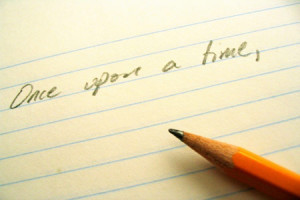 Many writing teachers urge new and not-so-new writers to free-write daily. Free-writing comes under other names called practice writing, daily writing, etc., but the concept behind it is the same. These writing exercises are for a writer what playing scales are for a musician or hitting balls are for a tennis player or golfer. They warm you up. They help you fine tune your style.
Many writing teachers urge new and not-so-new writers to free-write daily. Free-writing comes under other names called practice writing, daily writing, etc., but the concept behind it is the same. These writing exercises are for a writer what playing scales are for a musician or hitting balls are for a tennis player or golfer. They warm you up. They help you fine tune your style.
What exactly is free-writing? It is taking a piece of paper or your computer keyboard and you start to write without stopping. You never worry about spelling or editing. You don’t think, “I can’t say that, it’s weird.” You say it. You let it come out.
Even if you freeze you are not supposed to stop and think. You go on by repeating your last few words such as:
I went to the store to buy a case of Coke, a case of Coke, a case of Coke because I loved Coke since i was a kid, a kid, a kid, and my mother only would let me have three and my brother had the other three and and and and I often stole his. My sister, my sister, my sister always lurked, unseen, and waited for my brother and I to fight over one can of Coke, steal and hid the others.
Yes there are mistakes, yes there are repetitions, but the idea is to keep going without caring for punctuation, grammar, typos. You release words like waterfalls.
The idea behind it as that as writers we are stopped by what we feel is safe and correct. We constraint our writing within preconceived walls and tracks. We need to get away from that concept in free-writing. Often free-writing produces the energy that leads to other good writing. Take the free-write about the case of Coke. That led to a short story about sibling rivalry acted out with a brother and sister stealing each other’s treasures in the third person from the point of view of adults.
What if it doesn’t produce anything? So what? Does each piano scale produce a sonata? No, but with enough scale practice the sonata will be played better. You’re not supposed to publish free-writing.
Measurement
There are two ways to measure free-writes. One is by a timer set for ten minutes. The other is to fill up three pages. Less than that really isn’t enough. More is fine.
Starting
Put your pencil/pen/fingers to paper/keyboard and start and don’t stop until the time/pages are filled. Don’t answer the phone, go to the toilet or take a sip of tea.
What if you don’t know how to start?
1. Find a trigger such as emotional phrases: I love…, I hate…, I want…, it pisses me off…, I remember…, I don’t remember…
2. Use a color. I wanted to wear red as child but mother said it clashed with my hair. Work your way through the rainbow. Just think how many writing exercises you can do around different words for purple: lavender, lilac, violet, mauve, purple…
3. Find a sentence in a book, newspaper or magazine and use that as a trigger.
4. Use a piece of conversation that you overheard.
Where should I free write?
Anywhere you want: on a bus, train, airplane. In your kitchen, office. At a café. Sure it is ideal to be locked away with quiet or soft music in the background, but it is more important to do it.
What to do with your free-writing
1. Ignore what you wrote. No one ever needs to make every word written count. We don’t see the canvases that the artists didn’t like. A professor at Simmons College once said that every writer has 250,000 bad words in them. Free-writing gets rid of some.
2. Go get a cup of tea or coffee and come back and reread what you wrote circling something you like.
3. Transfer what you like into a journal for later use or not.
4. Develop what you started.
Set yourself the goal of free-writing for a month even if you have to lock yourself in a bathroom to do it. By then it will become a habit that you miss.
Nathalie Goldberg
Nathalie Goldberg is one of the strongest proponents of free writing but there is no common consensus on the acceptance of this technique: “For fifteen years now, at the beginning of every writing workshop, I have repeated the rules for writing practice. So, I will repeat them again here. And I want to say why I repeat them: Because they are the bottom line, the beginning of all writing, the foundation of learning to trust your own mind. Trusting your own mind is essential for writing.”
Note: Her rules include losing control and don’t think.
Give yourself a time limit. Write for one or ten or twenty minutes, and then stop.
Keep your hand moving until the time is up. Do not pause to stare into space or to read what you’ve written. Write quickly but not in a hurry.
Pay no attention to grammar, spelling, punctuation, neatness, or style. Nobody else needs to read what you produce here. The correctness and quality of what you write do not matter; the act of writing does.
If you get off the topic or run out of ideas, keep writing anyway. If necessary, write nonsense or whatever comes into your head, or simply scribble: anything to keep the hand moving.
If you feel bored or uncomfortable as you’re writing, ask yourself what’s bothering you and write about that.
When the time is up, look over what you’ve written, and mark passages that contain ideas or phrases that might be worth keeping or elaborating on in a subsequent free-writing session.
Goldberg’s rules appear to be based on those developed by Jack Kerouac, who she cites several times. Kerouac developed 30 “rules” in his Belief & Technique for Modern Prose. Kerouac prose writing method is a form of narrative stream of consciousness. Kerouac himself cites the “trance writing” of William Butler Yeats as a precursor of his own practice.
Goldberg’s rules, which are infused with the study and practise of Zen Buddhism, make the process of free writing more accessible for a beginner and are perhaps less extreme than those of Kerouac, although they are still tinged with an element of mysticism.
Massimo Marino is a scientist envisioning science fiction. He spent years at CERN and The Lawrence Berkeley Lab followed by lead positions with Apple, Inc. and the World Economic Forum. He is also co-founder of “Squares on Blue”, a Big Data Analytics service company.
Massimo currently lives in France and crosses the border with Switzerland multiple times daily, although he is no smuggler.
As a scientist writing science fiction, he went from smashing particles at accelerators at SLAC and CERN to smashing words on a computer screen.
He’s the author of multi-awarded Daimones Trilogy.
His novels have received the Seal of Excellency from both AwesomeIndies.net and IndiePENdents.org
• 2012 PRG Reviewer’s Choice Award Winner in Science Fiction
• 2013 Hall of Fame – Best in Science Fiction, Quality Reads UK Book Club
• 2013 PRG Reviewer’s Choice Award Winner in Science Fiction Series
• 2014 Finalist – Science Fiction – Indie Excellence Awards L.A.
• 2014 Award Winner – Science Fiction Honorable Mention – Readers’ Favorite Annual Awards
His novels are available from Amazon, Barnes & Noble (Nook), iTunes Apple Store, and many other retailers around the world.
Join his mailing list for new releases, or follow him on Facebook, Google+, and Twitter.
The post Words Without Chains appeared first on § Author Massimo Marino.
November 7, 2014
Independent Publishing: On Its Way and Here To Stay!
Shake, Rattle, and Roll!
If you’re like me, you’re a little tired of slams you hear against self-publishing and independent presses. They call it a substandard industry, a vanity pursuit, a joke. But you know it isn’t. It takes a lot of work to write a book and bring it to market, and if you independently publish your own books or are associated with a small press, then you are shaking up the book world!
You know what the problem is, don’t you?
Traditional publishers have long held an exalted position. They were the gatekeepers of ideas. They determined who was in and who was out, who was worthy and who was not. They decided what the public could read and what messages or entertainment to issue. They were the gatekeepers of ideas.That’s over now, and we have some statistics to prove it. The July 2014 Authors Earnings Reportsaid that self-published authors are “dominating traditionally published authors” in sci-fi/fantasy, mystery/thriller, and romance genres, and are also taking “significant market share in all genres.” The report also said that, “We can now say that self-published authors earn more in royalties than Big 5 authors, combined.”
 Further, the October 2014 Author Earnings Report concluded that, in the eBook market, independent authors are gaining share of daily revenue and Big Five authors are losing it.
Further, the October 2014 Author Earnings Report concluded that, in the eBook market, independent authors are gaining share of daily revenue and Big Five authors are losing it. So what about the gatekeepers? Quite simply, went around them. And thanks to the culture of karma and cooperation in the Indie market, you can produce a world-class book. But only if you’re determined to be a professional.
So what about the gatekeepers? Quite simply, went around them. And thanks to the culture of karma and cooperation in the Indie market, you can produce a world-class book. But only if you’re determined to be a professional.
Rise to the Market!
 Let’s face it. The first generation of self-published books was pretty awful. The author designed their own cover or had their child do it, skipped the editing step, and often used a 14-point font—double-spaced—to make their book seem longer. That’s not independent publishing. That’s do-it-yourself publishing, and there’s no excuse for that.
Let’s face it. The first generation of self-published books was pretty awful. The author designed their own cover or had their child do it, skipped the editing step, and often used a 14-point font—double-spaced—to make their book seem longer. That’s not independent publishing. That’s do-it-yourself publishing, and there’s no excuse for that.
In this second generation, the bar has been raised, and independent authors produce products that stand shoulder-to-shoulder with what comes out of publishing houses.
You can do it, but you can’t do it alone. So how does an independent author take their manuscript and turn it into a finished, professional product that’s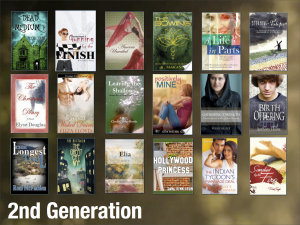 marketed around the world?
marketed around the world?
You work with professionals.
An entire author services market has emerged to usher you through the process. In the beginning, some providers took advantage of trusting authors and charged you an arm and a leg for substandard work.
Now reputable providers have raised the bar, and they keep the author at the center of the process. They cooperate with you. They’re givers, not takers. They know that the good they give out will return to them. That’s good karma!
By Nancy Baumann, CEO, Bookarma.
Karma and cooperation have changed the game in book marketing, too. Bookarma (pronounced book-karma) is a revolutionary new platform where authors help authors market their books globally through shared social networks.
The entire concept is based on karma and cooperation. Authors realize that they are not in competition with each other and they cooperate with each other. There are plenty of readers for everyone, and what you give out will return to you. That’s karma. That’s cooperation. That’s authors helping authors. And that’s what allows indie authors to reach a global audience without having to cultivate it by themselves.
The post Independent Publishing: On Its Way and Here To Stay! appeared first on § Author Massimo Marino.
November 3, 2014
What Publishers Don’t Want You To Know

SELF-PUBLISHED: James Augustine Aloysius Joyce (2 February 1882 – 13 January 1941), Irish novelist and poet, was considered to be one of the most influential writers in the modernist avant-garde of the early 20th century.
Julia Petrakis writes to us from the IndiePENdent.org organization.
The avalanche of self-published books creates a problem of legitimacy. Therefore, a group of us, authors and editors, is now forming a nonprofit organization, The indiePENdents, with the purpose of establishing standards and promoting independent writers. We will try to enlist the support of Amazon, Barnes&Noble, LuLu and mainstream publishers in creating standards and awards.
Authors write books. They represent the future of our culture. The indiePENdents want to give the creativity of the self-published authors an imprimatur, so to speak, in order to achieve the respectability and credibility that they are not presently given by the industry. Books that meet the standards will be awarded the indiePENdents’ Seal.
Julia: “As some of you may know, I have been for many years and still am an editor and back-of-the-book indexer. I work for traditional presses, think tanks and associations, individual academics and writers, and the A.T. Still University Student Writing Center. Until recently, as indexer, I received the final galleys or proofs, which had been copy edited and proofread; I found very few typos, inconsistencies, grammar or punctuation mistakes. Consequently, I did not know the quality of the writing of these educated, intellectual writers.
In the past month, I have been privileged to index for one of the major international academic presses and am currently indexing an edited compilation for a small association. Both books apparently came to me with little or no copy editing or proofreading and were/are full of errors. The first, a scholarly work of 300 or so pages, came to me with close to 100 queries and corrections. In the second, also a scholarly work, of which I have completed indexing 50 pages, I have already found approximately 50 queries and corrections. These range from inconsistencies in spelling and capitalization to incorrect book titles to sentences that make little or no sense.
Now, I am assuming these problems will be fixed before these books go to press. As they are, these books would not receive the indiePENdents’ Seal of Approval.
“So what does that mean for us?” you ask. What it means is that trad-published writing is not necessarily any better than self-published writing. It is just usually edited, copy edited, proofread, then checked again by the indexer and the compositor (modern-day typesetter) and then, once again, by the author before going to press, after which it is likely checked over again before the print run is approved. At the self-publishing level what this means is there will be many early drafts and even quite a few “final” drafts. (When Jasha Levi, our founder, and I published his book, Requiem for a Country: A History Lesson, on CreateSpace, we went through — and I still have on my computer — at least 10 of those “final” drafts).
Copy editing and proofreading do count. They are what takes a book from the “crap” critics of self-publishing so disparage to the level of those lucky few that make it past the trad-publishing gatekeepers and onto the NY Times best-seller lists.. The best of those books (whether they happen to be in a style or genre you like or not) have been polished until they shine like the best silver! Keep that in mind.”
Thank you, Julia, for sharing your words with us. This testimonial—and from someone who like you has seen it first hand—should be read once a week. “The avalanche of self-published books creates a problem of legitimacy,” and publishing houses are desperate to make readers believe that without their ‘imprimatur’ a writer is not worth to be read, but good writers write from every place and in every position. Today’s digital revolution in publishing hurts the middleman of the relationship that blossoms between authors and readers, and the middleman is one man too many in that relationship and needs to re-invent his role in this new era.
Today, writers write and readers read; in this equation all important factors are present, and for a writer that’s all that counts.
Thanks to the indiePENdents, and other organizations with same purposes and goals, for promoting good independent writers, at least those who have many ‘final’ drafts before sending the manuscript to beta-readers, get one more ‘final’ draft in the hand of the editor, and have a proofreading before hitting the ‘publish’ button.
Keep in mind that, as an independent author, it is also your role to help eliminate valid cause for negative perceptions of independently published books based solely on their publishing provenance. Write good stories, but don’t stop there. Rewrite, rinse and repeat, polish and have them polished until they shine before enjoying the privilege of being read by readers.
Massimo Marino is a scientist envisioning science fiction. He spent years at CERN and The Lawrence Berkeley Lab followed by lead positions with Apple, Inc. and the World Economic Forum. He is also co-founder of “Squares on Blue”, a Big Data Analytics service company.
Massimo currently lives in France and crosses the border with Switzerland multiple times daily, although he is no smuggler.
As a scientist writing science fiction, he went from smashing particles at accelerators at SLAC and CERN to smashing words on a computer screen.
He’s the author of multi-awarded Daimones Trilogy.
His novels have received the Seal of Excellency from both AwesomeIndies.net and IndiePENdents.org
• 2012 PRG Reviewer’s Choice Award Winner in Science Fiction
• 2013 Hall of Fame – Best in Science Fiction, Quality Reads UK Book Club
• 2013 PRG Reviewer’s Choice Award Winner in Science Fiction Series
• 2014 Finalist – Science Fiction – Indie Excellence Awards L.A.
• 2014 Award Winner – Science Fiction Honorable Mention – Readers’ Favorite Annual Awards
His novels are available from Amazon, Barnes & Noble (Nook), iTunes Apple Store, and many other retailers around the world.
Join his mailing list for new releases, or follow him on Facebook, Google+, and Twitter.
The post What Publishers Don’t Want You To Know appeared first on § Author Massimo Marino.




